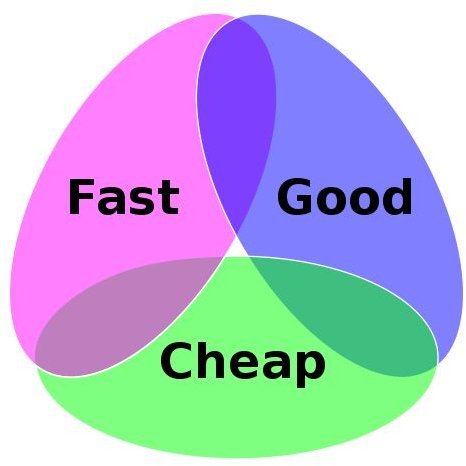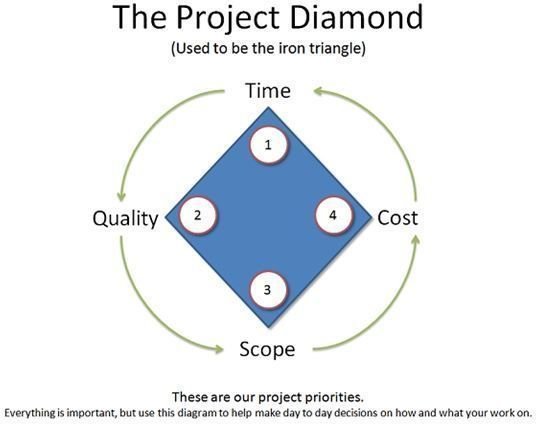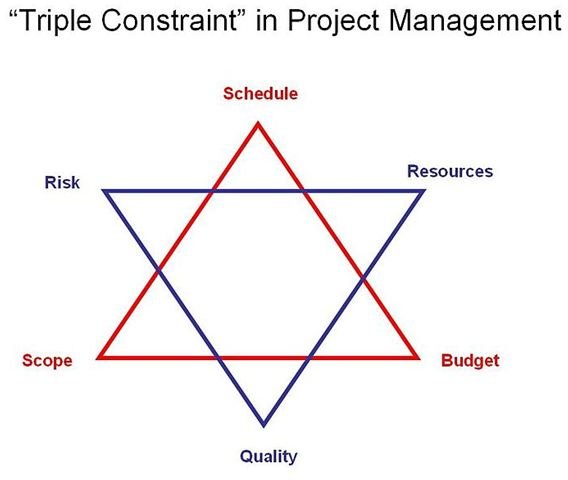The Evolution and Variations of the Classic Project Management Triangle
Project management has been around, at least in concept, for thousands of years. While no Pert charts have been discovered etched into the side of ancient stone tablets, there is indication that different “managers” were delegated to create each of the four faces of the Great pyramid of Giza in 2570 BC.
In the early 1900’s, the Gantt chart was developed by Henry Gantt.
In the early 1950’s, CPM (Critical Path Method) was defined and the evolution of project management gained swift momentum forward.
One of the tools project managers use to organize their thoughts and to communicate project complexities to others is the “project management triangle” (aka “project constraint triangle”, “iron triangle”).
In the 1970s, Dr. Martin Barnes, an engineering expert in the UK, created the “cost/time/quality triangle” with which we are all familiar.
The Triple Constraints
There were soon problems as people had different definitions of the “quality” side of the triangle. Dr. Barnes recognized that and
attempted to redefine the triangle as “cost/time/performance.” There was resistance to adopting this model as the more popular version “cost/time/scope” was beginning to take shape.
This is considered the classic project management triangle.
The amount of time it takes to complete a project is the time (schedule) leg of the triangle. The overall budget is the cost leg. The scope constraint is all of the work that must be completed to satisfy the project requirements.
When working with the triangle, it is initially drawn as an equilateral triangle where all sides are the same length. When using the graphic to communicate things that impact the project, one can show that anything that increases one constraint leg will impact the length of the other sides of the triangle.
Ideally, the equilateral triangle represents a project at its initial baseline state. Often, the word “quality” is written in the middle of the triangle. The initial triangle represents the concept that when all of the known cost, time and scope constraints are working together, the desired project quality will be achieved.
As the project moves forward, and sometimes before it even gets started, changes in the three constraints will occur, impacting the other two constraints. The customer increases the scope which generally means an increase in cost and time. An acceleration of the schedule (time) may result in an increase in costs and a reduction in scope. A reduction in the budget (cost) may require reducing the scope and extending the schedule (time).
Each of these impacts are easily communicated by redrawing the triangle to reflect the changes.
The value of using a graphic such as the project management triangle is in communicating the complexity of a project and the impact of various changes. While the concepts remain the same, the graphic has changed to meet the needs of the project manager to present the project status and facilitate discussions.
Variations of the classic project management triangle have been created to focus on unique projects and their challenges.
Changing the Constraints As Needed
Another way to structure the triangle is by using finance, time and human resources. This may be an appropriate way to discuss a project that has a fixed scope, such as in manufacturing or construction.
Here the PM can show that if a project needs to be completed sooner, adding more resources will increase the cost of the project. Or if the budget and resources must be reduced, the time/schedule must be extended.
Another way the constraint names have been changed is to use time, resources and technical objective. This can be effective in an engineering setting.
Changing the Diagram As Needed
An informal discussion can be had by creating the triangle as a Euler diagram. A Euler diagram uses intersecting circles and ovals to

represent the state of each constraint
In this example, the constraints show up as Fast (time), Good (quality) and Cheap (cost). When using this diagram, the audience is told to pick two. This diagram displays that all three elements of the project are interconnected. Only two elements may change at the expense of the third:
- We can do the project quickly with high quality, but it will be costly
- We can do the project quickly at a reduced cost, but quality will suffer
- We can do a high quality project at a reduced cost, but it will take much longer
The Model Evolves
The difficulty in discussing projects in terms of the three constraints, cost, time and scope, without considering quality resulted in the

creation of the “project management diamond.”
The diamond model adds quality as a fourth constraint. While the diagram now includes quality in the discussion, some of the ease of demonstrating how the various constraints are impacted by changes in other constraints begins to get lost
In the Fourth Edition of A Guide to the Project Management Body of Knowledge (Project Management Institute, 2009) yet another model was introduced. This one is based on the triple constraint but includes 6 elements to be managed.
The Star m

odel includes Scope, Cost, Time, Risk, Quality and Resources.
The purpose of this model was to make a distinction between project inputs on one triangle and project processes on the other triangle.
While incorporating more elements that reflect the real world of project management, the graphic becomes very challenging to use as a discussion tool
The Future of the Project Management Triangle
I am personally looking forward to the release of the Triacontakaipentagon Model, a diagram with 35 sides. This represents the project constraints that I often encounter in project management!
Seriously, in the latest version of the Project Management Body of Knowledge (PMBOK), PMI minimizes the project management triangle because every project has many more constraints than cost, time and scope.
The concept of the project management triangle is still solid. It is a good way to have high level discussions about the impact of changes on a project. Variations of the classic project management triangle will continue to evolve. Since change management is a huge component of project management, the triangle, in whatever form it needs to be to get the message across, will continue to be a valuable resource in any project managers’ toolbox.
References
- Image Credit: The Star Model - Wikimedia Commons/Catalin Bogdan, 2010/ Public Domain License
- Image Credit: The Diamond Model - Wikimedia Commons/Craig Brown, 2009/ Attribution-Share Alike 3.0 Unported License
- Image Credit: The Euler Diagram - Wikimedia Commons, 2010/ Public Domain License
- Project Management Institute, “A Guide to the Project Management Body of Knowledge: PMBOK Guide”, Fourth Edition, 2009
- Image Credit: The Triple Constraint Diagram - Wikimedia Commons/John M. Kennedy T., 2008/ GNU Free Documentation License
- Project Management World Today, “Interview with Martin Barnes - Project Management Pioneer”, Volume XI - Issue VI, June 2009
